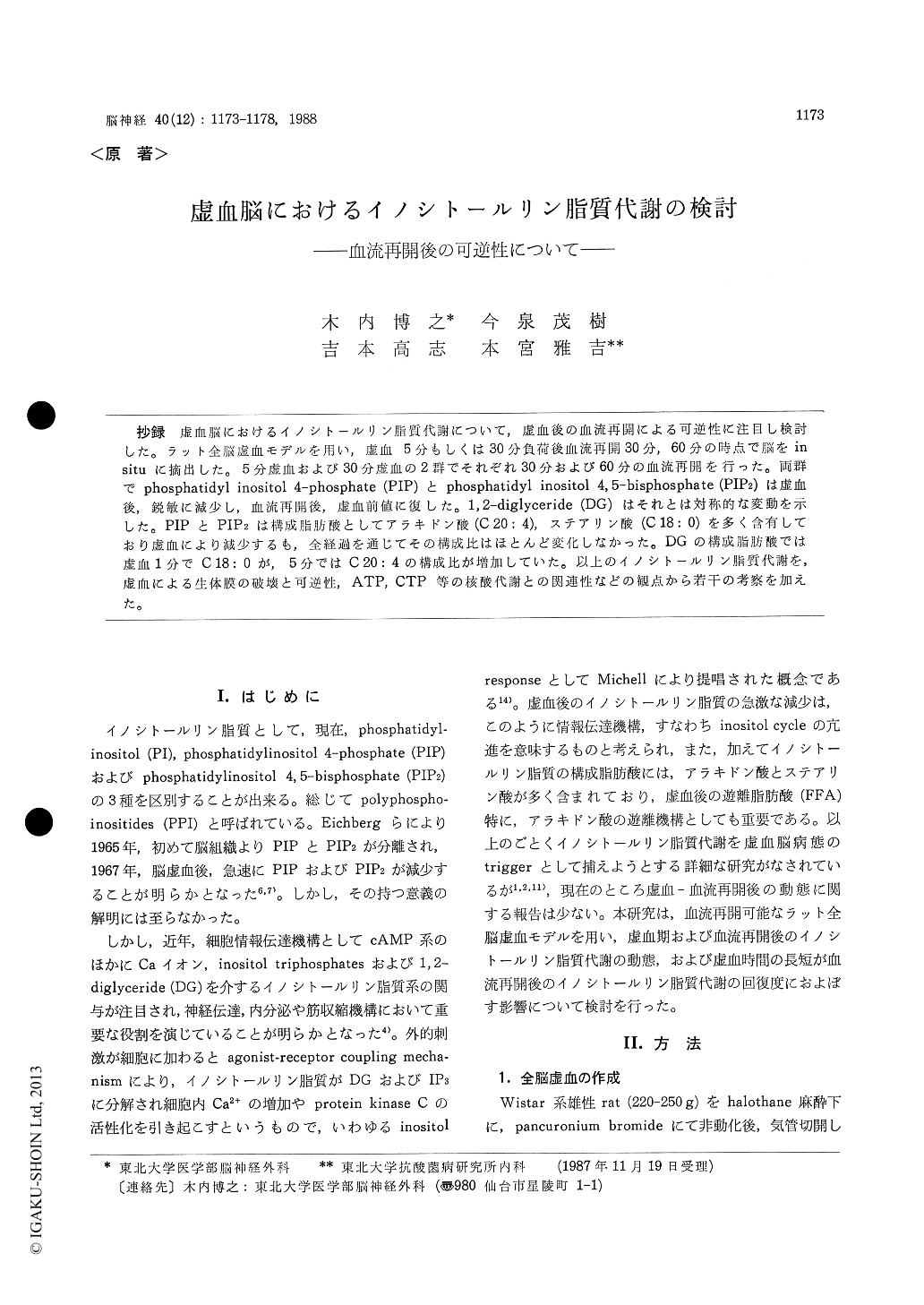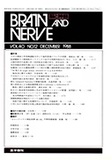Japanese
English
- 有料閲覧
- Abstract 文献概要
- 1ページ目 Look Inside
抄録 虚血脳におけるイノシトールリン脂質代謝について,虚血後の血流再開による可逆性に注目し検討した。ラット全脳虚血モデルを用い,虚血5分もしくは30分負荷後血流再開30分,60分の時点で脳をinsituに摘出した。5分虚血および30分虚血の2群でそれぞれ30分および60分の血流再開を行った。両群でphosphatidyl inositol 4-phosphate (PIP)とphosphatidyl inositol4, 5-bisphosphate (PIP2)は虚血後,鋭敏に減少し,血流再開後,虚血前値に復した。1,2—diglyceride (DG)はそれとは対称的な変動を示した。PIPとPIP2は構成脂肪酸としてアラキドン酸(C 20:4),ステアリン酸(C 18:0)を多く含有しており虚血により減少するも,全経過を通じてその構成比はほとんど変化しなかった。DGの構成脂肪酸では虚血1分でC18:0が,5分ではC20:4の構成比が増加していた。以上のイノシトールリン脂質代謝を,虚血による生体膜の破壊と可逆性,ATP, CTP等の核酸代謝との関連性などの観点から若干の考察を加えた。
Brain cell membranes are known to abound in polyphosphoinositides (PPI) which contain large amounts of arachidonic acid and stearic acid. When a state of cerebral iscehmia comes about, there occurs severe energy depletion and decomposition of PPI into diglyceride (DG) and inositol triphos-phate (IP3) through activation of phospholipase C. Previous studies clarified rapid postischemic degra-dation of PPI, a time during which the metaboli-cally active fraction of PPI is lost, but there have been no reports on PPI metabolism after the es-tablishment of recirculation following ischemia.
The authors examined relationship between the duration of the ischemia and the reversibility ofPPI metabolism in rats with cerebral ischemia lasting 5 or 30 min that was followed by recircula-iton, and, further studied acyl group composition of PPI and DG in rats with 30 min of ischemia.
Global cerebral ischemia was produced in male Wiatar rats (220-250g) by occlusion of basilar and bilateral common carotid arteries. The brains were frozen in situ at 1, 5, or 30 min of ischemia, or at 30 or 60 min of recirculation following either 5 or 30 min of ischemia. Phosphatidylinositol (PI), phos-phatidylinositol, 4-phosphate (PIP), phosphatidyl-inositol, 4, 5-bisphosphate (PIP2), and DG were measured by TLC, and GLC. And also their acyl group compositions were determined.
PI showed no significant changes. In contrast, both PIP and PIPs sharply decreased immediately after onset of cerebral ischemia. then continued to fall gradually from 5 min onwards. And PIP and PIP 2 increased after onset of recirculation in both 5 and 30 min ischemia groups. While DG showed sharp increases in the early stage of ische-mia and continued to increase at 30 min after its onset. They decreased after onset of recirculation to return to pre-ischemia level at 30 min. As the acyl group composition, PPI contained large a-mounts of arachidonic acid and stearic acid, but there were no changes through out the entire course. For DG, there were increases in the stearic acid ratio at 1 min of ischemia and in the arachi-donic acid ratio at 5 min of ischemia. Following recirculation, the acyl group compositions approxi-mately returned to the preischemia levels.
Our results clearly demonstrated the PPI meta-bolism in temporary cerebral ischemia. PPI meta-bolism had the reversibility after both 5 and 30 min of ischemia. The changes in PPI are thought to act as trigger for ischemic conditions such as in-crease in intracellular Ca ions, activation of protein kinase C, and release of arachidonic acid. More-over, the extremely rapid recovery of PPI follow-ing recirculation tells of the necessity of the pre-ferential recovery of the cell function.

Copyright © 1988, Igaku-Shoin Ltd. All rights reserved.


